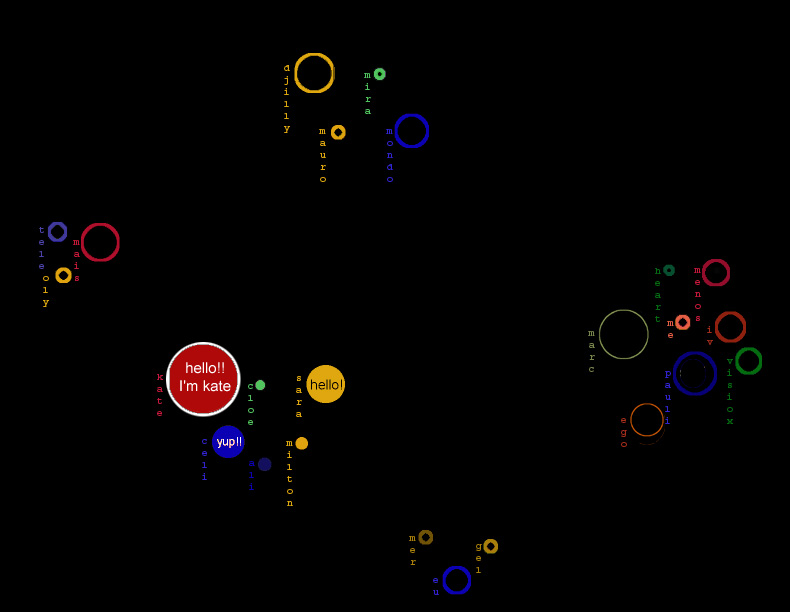Teaching:TUW - UE InfoVis WS 2006/07 - Gruppe 03 - Aufgabe 3 - Technique
Conversation Landscape[edit]
What is a Conversation Landscape?[edit]
Chat Circles Description[edit]
A Conversation Landscape is based on "Chat Circles", which is a technique for vizualising chats.
Mainly to get an better overview of the social interactions taking place in the chat.
In text-based chats (z.B. IRC) presence is shown only when one is actively messanging thats why silence and absence can't be distinguished.
In graphical chat systems people ar presented by a figure in a pictorial space. Avatars can be pictures, drawings or icons that users choose to represent themselves. It is visible so long as one is connected to the system.
Chat Cirles is a graphical interface for synchronous communication.
Conversation Landscape[edit]
Conversation Landscapes are an interface to visualize the archive of Chat Cirles. In this 2D modell, chat user are arranged along the x axis and the y axis represent time. The horizontal lines are postings, a longer line represents a longer posting.
The viewer can easily read out the time between postings as periods of silence. Convesation Landscapes show the interaction patterns of the conversation at a glance, flurries of animated discussion are as easily readable as logins and logouts.
Additional Information: What is Loom?[edit]
Loom is a visualization tool for conversations and interqactions in usenet groups. It will not be implemented and so this is only a short additional information. In the most basic setting of Loom dots represent individual postings. The more advanced setting traces the connection between sequential posts in a thread. It is also possible to visualise the content of the messages, for example the mood (angry, peaceful) in which it was written or the type (question or answer).
Visual Mapping[edit]
- Chat interface
Every person who is participating in the chat is represented with a coloured circle, every color is unique for each user. The messages of the user appears in this circle. The message frequence of a user, that means how active a user is, is shown as a color varation of the circle. It becomes bigger and brighter with every message the user types. After a period of silence the circle becomes smaller and starts to fade out, but is still visible. The different topics are shown as groups of circles, a user can only "hear" other people within the "hearing range".

- Archive interface
The archival interface of the chat circles is the Conversation Landscape. In this two-dimensional model of the conversation the communication history of the participants is shown. Every user is again identified with a specific color. The x Axis represents the users and the y axis the Time. The Postings are shown as a horizontal line. A longer message is shown as a longer line.

Interaction practices[edit]
User-Interaction[edit]
The user can choose the color of his/her circle. The user can move the own circle around. So identity is marked by color and position.
In Conversation Landscape users can interact with the visualisation to see individual conversations (users line) and read the postings (select horizontal bar). Single postings can be accessed on the history threads through a mouse-over effect.
Use of Interactions[edit]
- Highlighting of a thread. After focusing of an individual interaction history the thread along with the portions of other threads that were within hearing range is highlighted.
- Zooming of the whole conversation landscape
- Navigation within the landscape
- Textual Search within the messages.
- Dynamic querying of the shown area.
References[edit]
- [Donath et al., 1999] Donath, J., Karahalios, K., and Viegas, F.: Visualizing Conversation. In Proceedings of the 32nd Annual Hawaii International Conference on System Sciences (HICSS) - Volume 2, page 2023. IEEE Computer Society, 1999.http://ieg.ifs.tuwien.ac.at/~aigner/teaching/infovis_ue/papers/ConversationLandscapes_VisualizeConv.pdf
- [Fernanda et al., 2002] Fernanda B. Viégas and Judith S. Donath.: Chat Circles Created at: 14, March 2000 . Retrieved at: Dezember 1, 2006. http://smg.media.mit.edu/papers/Viegas/ChatCircles/chat-circles_CHI.html.